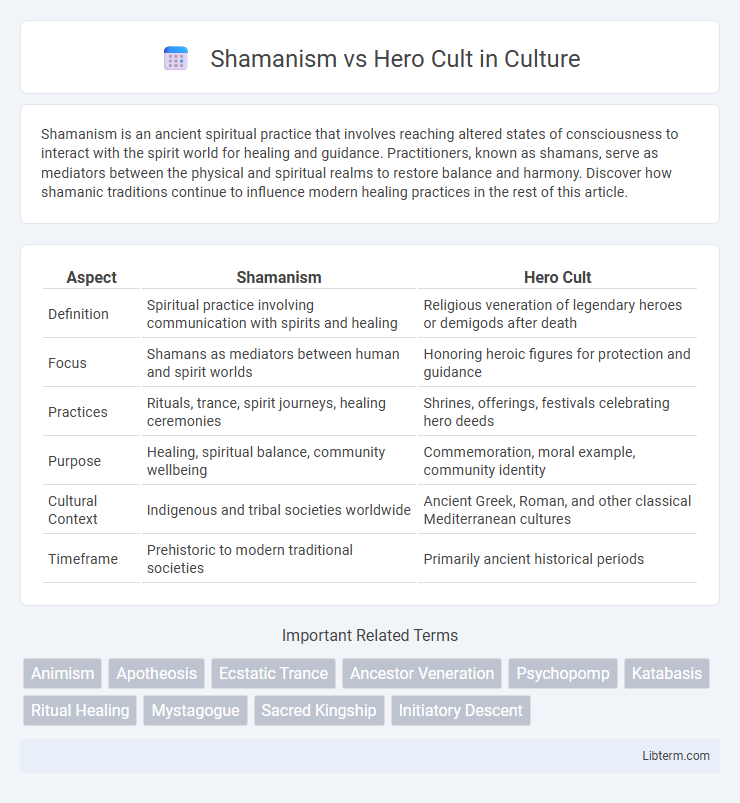Shamanism is an ancient spiritual practice that involves reaching altered states of consciousness to interact with the spirit world for healing and guidance. Practitioners, known as shamans, serve as mediators between the physical and spiritual realms to restore balance and harmony. Discover how shamanic traditions continue to influence modern healing practices in the rest of this article.
Table of Comparison
| Aspect | Shamanism | Hero Cult |
|---|---|---|
| Definition | Spiritual practice involving communication with spirits and healing | Religious veneration of legendary heroes or demigods after death |
| Focus | Shamans as mediators between human and spirit worlds | Honoring heroic figures for protection and guidance |
| Practices | Rituals, trance, spirit journeys, healing ceremonies | Shrines, offerings, festivals celebrating hero deeds |
| Purpose | Healing, spiritual balance, community wellbeing | Commemoration, moral example, community identity |
| Cultural Context | Indigenous and tribal societies worldwide | Ancient Greek, Roman, and other classical Mediterranean cultures |
| Timeframe | Prehistoric to modern traditional societies | Primarily ancient historical periods |
Understanding Shamanism: Origins and Practices
Shamanism originates from ancient animistic traditions where shamans act as spiritual intermediaries between the human and spirit worlds, utilizing rituals, trance states, and healing practices to restore balance and guide communities. Hero cults, however, center on venerating legendary figures or ancestors believed to possess supernatural powers, often involving offerings and commemorative ceremonies to honor their legacy. Understanding these distinctions highlights shamanism's active spiritual mediation contrasted with hero cults' focus on ancestral worship and mythic hero veneration.
Hero Cults in Ancient Societies: A Brief Overview
Hero cults in ancient societies served as focal points for communal identity and religious practice, venerating legendary figures believed to possess extraordinary powers or heroic virtues. These cults facilitated the integration of myth and history, fostering social cohesion through rituals, sacrifices, and commemorative festivals dedicated to heroes such as Heracles in Greece or Gilgamesh in Mesopotamia. The worship of heroes often involved the sanctification of tombs or shrines, reinforcing the connection between the living community and their ancestral protectors while promoting moral exemplars within the societal framework.
Core Beliefs: Shamanic and Heroic Worldviews
Shamanism centers on the belief in spiritual intermediaries who communicate with spirits to heal and guide communities, emphasizing a harmonious relationship between humans and the spiritual realm. Hero Cults focus on venerating legendary heroes as semi-divine figures whose extraordinary deeds grant them protective and intercessory powers after death, reinforcing social values and ancestral connections. The shamanic worldview embraces transformation and spiritual journeying, while the heroic worldview highlights legacy, honor, and the ongoing influence of heroic ancestors in the living world.
Rituals and Ceremonies: Comparing Practices
Shamanism rituals typically involve trance states, spirit communication, and healing ceremonies facilitated by the shaman to mediate between the physical and spiritual worlds, often using drums, chants, and symbolic objects. Hero cult ceremonies emphasize commemorative rites honoring deceased legendary figures, including offerings, sacrifices, and public festivals designed to invoke the hero's protective or intercessory power. While shamanistic practices focus on direct spiritual interaction and communal healing, hero cult rituals center on veneration, memory preservation, and the social reinforcement of cultural values.
Mediators of the Divine: Shamans vs Heroic Ancestors
Shamans act as direct mediators between the human and spirit worlds, using ritual trance and spiritual journeying to communicate with gods, ancestors, and nature spirits for healing and guidance. In contrast, heroic ancestors in hero cults serve as revered intermediaries whose legendary deeds grant them ongoing influence and protection over their descendants and communities through ritual veneration. While shamans actively navigate supernatural realms to harness spiritual power, heroic ancestors function as symbolic figures embodying cultural ideals and ancestral authority.
Symbolism and Mythology: Stories that Shape Belief
Shamanism employs animal totems, spirit guides, and natural elements as symbols in myths that emphasize transformation and connection to the spiritual realm. Hero cults revolve around legendary figures and their extraordinary deeds, using symbols like weapons, crowns, or burial sites to reinforce their legendary status and divine favor. Both systems utilize storytelling to embed moral values and cultural identity through powerful mythological narratives.
Social Roles: Shamans as Healers, Heroes as Legends
Shamans serve as essential healers and spiritual guides within their communities, utilizing rituals and herbal medicine to restore physical and psychological well-being. Heroes function as legendary figures, embodying cultural values through heroic deeds and inspiring collective identity and moral ideals. These social roles highlight shamans' active participation in maintaining communal health, while heroes symbolize cultural virtues and societal aspirations.
Sacred Spaces: Shrines, Temples, and Ritual Sites
Shamanism centers around natural sacred spaces such as caves, forests, and mountains where shamans perform rituals to connect with spirits and ancestors. Hero cults typically establish permanent shrines or temples dedicated to legendary heroes, serving as focal points for communal worship and offerings. Both traditions emphasize ritual sites as vital venues for spiritual interaction, but shamanistic spaces remain fluid and nature-bound, whereas hero cults institutionalize sacred architecture.
Transformations and Initiations in Both Traditions
Shamanism involves transformative initiations where individuals undergo intense spiritual journeys, often through altered states of consciousness, to connect with the spirit world and gain healing powers. Hero cults center on initiations that commemorate legendary figures who undergo heroic trials or death and resurrection, symbolizing societal ideals and chthonic transformations. Both traditions emphasize rites of passage that facilitate profound metaphysical changes, linking personal or communal identity with the supernatural realm.
Modern Reflections: Shamanism and Hero Worship Today
Modern reflections of shamanism reveal a resurgence in the use of ritualistic healing and spiritual journeys as means of personal transformation and community connection. Hero cults today manifest through celebrity worship and cultural iconography, symbolizing collective values and aspirations in contemporary society. Both practices emphasize transcendence, symbolism, and the mediation between the human and supernatural realms, adapting ancient spiritual frameworks to modern existential needs.
Shamanism Infographic

 libterm.com
libterm.com